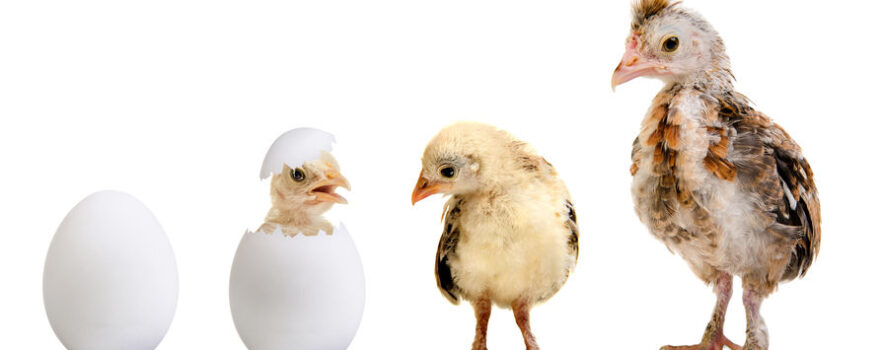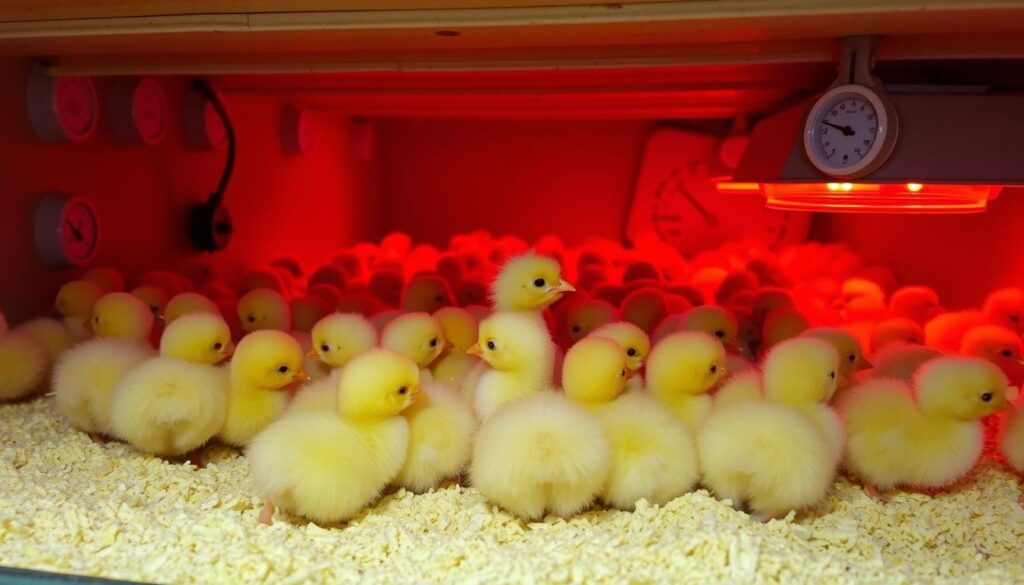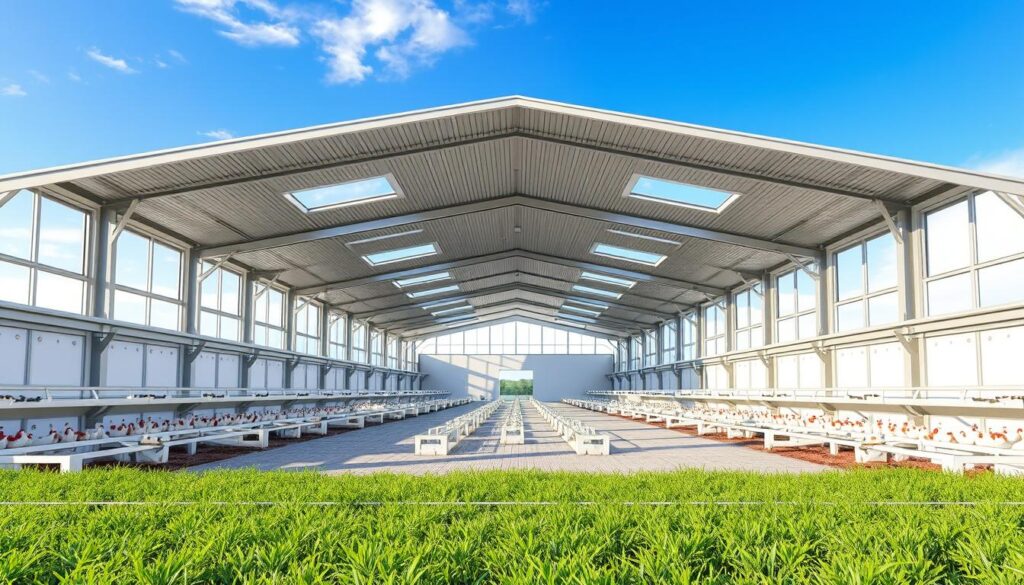
To make a profitable broiler, you need to meet certain standards early on. This includes setting high-quality fertile eggs in incubators and handling them right. Egg size, weight, and quality are key because they affect chick weight and quality.
Well-run farms aim to have chicks grow 4.5–5 times their original weight by 1 week. This growth depends on several factors. These include chick health, feed and water availability, brooding environment, and air quality.
Key Takeaways
- Egg quality and handling are crucial for optimal broiler chick development.
- Achieving 4.5-5 times the original chick weight by 1 week of age is a key benchmark.
- Chick health, feed and water access, brooding conditions, and air quality impact early growth.
- Monitoring broiler performance throughout the grow-out stages is essential for management.
- Genetic factors and breed selection play a role in broiler growth potential.
Hatchery Practices for Optimal Broiler Growth
Egg Selection and Handling
Starting with the right eggs is key to growing strong broilers. Eggs should weigh at least 50 grams for the best results. This weight ensures the chicks grow big and healthy.
Keeping eggs at the right temperature and humidity is also vital. This helps the eggs stay good for incubation. Eggs should be used within 3 days to keep them fresh and viable.
Incubation and Hatching Conditions
Getting chicks to hatch well requires careful attention to incubation. The goal is to have 93.5% of eggs hatch successfully. This means keeping the temperature, humidity, and air flow just right.
It’s also important to watch for any chicks that don’t hatch right. They should be very rare. This ensures all chicks are healthy and ready to grow.
Research shows that chicks hatched on-farm start bigger than those from hatcheries. But, they catch up by day 7. This means both types of chicks grow at similar rates after that.
The type of bacteria in chicks’ guts is more about their size than where they were hatched. However, there are differences in gut bacteria between heavier and lighter chicks. These early differences can affect how well they grow later on.
Key Factors Influencing Growth at Each Stage of Broiler Chicken Development
Many factors affect broiler growth at each stage. These include genetics, nutrition, environment, health, and management practices. It’s important to track weekly body weight and daily weight gain to ensure proper growth.
A well-managed broiler should gain about 65 grams or more each day. But, many factors can change this growth rate, either positively or negatively.
Genetic Factors
The broiler’s genetic strain greatly affects its growth. Fast-growing breeds like Cobb and Ross are chosen for their quick weight gain. But, this fast growth can lead to leg problems, making good management crucial.
Nutrition and Feeding
A balanced diet with the right protein and energy is key for growth. Feed efficiency, intake, and deprivation can all affect growth. Also, how the feed is placed and the litter quality are important for performance.
Environmental Factors
Temperature, ventilation, and air quality are vital for broiler growth. Heat stress can lower feed intake and weight gain. Keeping the brooding temperature right and ensuring good air quality are essential for growth.
Health and Disease Management
Diseases can greatly slow down broiler growth. They can reduce feed efficiency and weight gain. It’s important to prevent diseases and manage health well to keep broilers performing at their best.
Understanding and managing these factors at each stage can help producers improve growth. This way, they can reach their production goals.
| Factor | Impact on Broiler Growth |
|---|---|
| Genetics | Genetic strain influences growth potential and susceptibility to leg disorders |
| Nutrition | Balanced protein and energy levels, feed efficiency, and feed management are crucial |
| Environment | Temperature, ventilation, and air quality can significantly affect growth and performance |
| Health | Disease outbreaks and health issues can severely hinder growth and feed efficiency |
“Maintaining ideal brooding temperature and ensuring proper air quality are critical for supporting broiler development.”
Importance of Brooding Temperature and Environment
Keeping the right brooding temperature and environment is key for broiler chickens’ early growth. In the first week, the temperature should not go over 90°F (32°C). This helps avoid dehydration and ensures good weight gain.
Chicks are mostly water at hatch, so the right temperature and plenty of fresh water are crucial.
Ideal Brooding Temperature Range
The best brooding temperature ranges for broiler chickens are:
- 0 to 1 week: 93° to 95°F (33.9° to 35°C)
- 1 to 2 weeks: 88° to 90°F (31.1° to 32.2°C)
- 2 to 3 weeks: 83° to 85°F (28.3° to 29.4°C)
- 3 to 4 weeks: 78° to 80°F (25.6° to 26.7°C)
- 4 to 5 weeks: 75°F (23.9°C)
- 5 to 6 weeks: 70°F (21.1°C)
- 6 weeks and over: Comfort Zone 50° to 70°F (10° to 21.1°C)
Ventilation and Air Quality
Good ventilation and air quality are also vital. Fresh air helps chicks breathe well and stay healthy. It’s important to manage ventilation and check air quality to avoid problems.
Studies show that even small amounts of ammonia can harm broilers. Keeping humidity levels between 50% and 70% helps reduce ammonia and bacteria.

“Chicks can be stressed if their body temperature changes by even as little as one degree, negatively impacting their performance.”
By managing brooding temperature and environment well, producers can help chicks grow and perform better. This sets them up for success.
Feeding and Nutrition for Optimal Growth
It’s key to give broilers a balanced, high-quality feed for growth and performance. They need a starter feed with at least 18% protein in the first weeks. The feed must have the right mix of energy, amino acids, vitamins, and minerals.
Balanced Protein and Energy Levels
Broilers should eat at least 170 grams of quality feed in the first week. Early access to feed and water is crucial for supporting growth, as for every 24 hours of feed deprivation after hatching, body weight at the end of fattening decreases by about 3%. (De jong et al., 2017)
Feeder space affects feeding behavior. It should be between 1.5 to 2.1 cm (Cobb, 2018), 1.7 cm (Aviagen, 2015), and 2.5 to 5.1 cm (Sasso, 2018). A study found chickens with 6.9 cm of feeder space were 6% and 4% heavier at 28 days than those with 2.3 cm and 4.6 cm, respectively (Purswell et al., 2021).
The best pellet size for chicken feed from 7 days is 3 mm in length and diameter. This helps them eat more and grow better (Abdollahi and Ravindran, 2013a). Adding whole grain to their diet can lower feed intake by 0.2-16%. But, it can also improve their gut health and growth (Abdollahi et al., 2018).
Ad libitum feeding leads to 4–10% more feed intake and 3–4% more body weight gain than intermittent feeding (Sacranie et al., 2012; Svihus et al., 2010). Chickens under heat stress eat 3–4% more, gain 5% more weekly, and weigh 4% more at six weeks with feed only during stressful hours compared to ad libitum feeding (Erensoy et al., 2020).
Genetic Factors and Breed Selection
The genetic makeup and breed of broiler chickens greatly affect their growth. Some breeds grow faster than others. This makes choosing the right breed key for better broiler performance. Researchers have looked into the genetic factors that affect growth in yellow-feather broilers, a common breed in China.
A recent study used a special method to study nine growth traits in yellow-feather broilers. They found a key genetic region on chromosome 15 that affects growth. They also found important genes like NRAS, TUBB1, and NGF that play a role in their growth.
Breed selection and genetics are crucial in the poultry industry. Old methods focused on physical traits, while new ones use four pure breeds to boost productivity. Genetic selection looks at traits like egg production and disease resistance.
Genomic research has given us new insights into broiler chicken traits. By understanding these genetic factors, producers can choose the best breeds. This leads to better growth, productivity, and profits.
Housing and Space Requirements
The environment and housing for broiler chickens are key to their growth. They need enough space to move and exercise. Overcrowding can cause leg problems and slow weight gain.
It’s important to follow stocking densities and floor space allowances. This ensures broilers can grow well without discomfort.
Stocking Density and Floor Space
The EU Directive (2007/43/EC) says broilers need dry, friable litter. In the EU, most are raised in loose systems on concrete floors with deep litter. But, these systems can cause health issues like respiratory diseases and foot pad dermatitis if not managed right.
Multi-tier colony cage systems are becoming more popular. They’re more efficient and cost-effective. Both multi-tier cages and deep litter systems score well in broiler welfare, according to the Welfare Quality® assessment protocol (WQP).
| Housing System | Stocking Density | Floor Space Allowance |
|---|---|---|
| Traditional Litter-based | 15.75 chicks/m² | 1 sq ft per broiler |
| Multi-tier Colony Cages | 15.75 chicks/m² | 1 sq ft per broiler |
Good litter management is vital for broiler welfare and performance. It’s important to keep the right temperature, relative humidity, ammonia levels, and litter moisture. This creates a healthy environment for the broilers.

Disease Prevention and Health Management
Keeping flocks healthy is key for better growth and productivity in broilers. This means using strict biosecurity, effective vaccines, and clean practices from hatch to farm. Stopping common diseases helps avoid growth issues and death.
Biosecurity is the main defense against diseases. It includes controlling who comes to the farm, cleaning equipment, and limiting movement. Keeping the farm clean and managing waste well are also important.
Vaccines play a big role in keeping broilers healthy. Programs that target diseases like Newcastle and infectious bronchitis help a lot. It’s important to follow the vaccine schedule and check if it’s working well.
| Key Broiler Health Management Strategies | Importance |
|---|---|
| Biosecurity | Controlling access, disinfecting equipment, and restricting movement to prevent disease introduction (73-78% of global poultry production challenges) |
| Vaccination | Effective vaccination programs targeting common poultry diseases (26% effectiveness in poultry production) |
| Hygiene Practices | Regular cleaning, disinfection, and proper waste management to maintain a clean and healthy environment (7-9% prevalence of infectious diseases in broiler chickens) |
By using full broiler health programs, producers can make their flocks healthier and more productive. This, along with other good practices, helps make sure broilers are raised well and efficiently.
Growth Monitoring and Performance Tracking
It’s key to watch how broiler chickens grow and perform. This helps spot and fix any problems that might slow them down. By tracking their weight each week, farmers can see if their birds are growing as they should.
Weekly Body Weight Targets
There are set weight goals for broilers at each life stage. Farmers check their birds’ weights weekly. This way, they can make changes if needed to help their birds grow right.
- Chicks (1-7 days): 150-200 grams
- Starter (8-21 days): 600-800 grams
- Grower (22-35 days): 1,500-1,800 grams
- Finisher (36-42 days): 2,200-2,500 grams
Average Daily Weight Gain
The average daily weight gain shows how well broilers are doing. Broilers should gain about 65 grams a day to grow well. Farmers watch this closely and adjust things like food and health care to help them grow best.
| Stage | Average Daily Gain (grams) |
|---|---|
| Chicks (1-7 days) | 20-30 |
| Starter (8-21 days) | 50-60 |
| Grower (22-35 days) | 70-80 |
| Finisher (36-42 days) | 80-90 |
By keeping a close eye on broiler growth tracking, body weight goals, and growth rate monitoring, farmers can make sure their broilers grow to their best. This helps the farm run smoothly and efficiently.
Broiler farmers can improve their operations by focusing on key areas. These include hatchery management, feeding, environmental control, genetic selection, and health programs. By monitoring growth and solving problems, they can help their broilers grow well.
This approach leads to better production and more profit. The article has shown how important each step is for broiler performance. It’s all about a detailed plan to boost growth and productivity.
Broiler chickens success comes from knowing how to manage their growth. Keeping up with new ideas and best practices is crucial. This way, farmers can make their operations better and stay ahead in the poultry business.